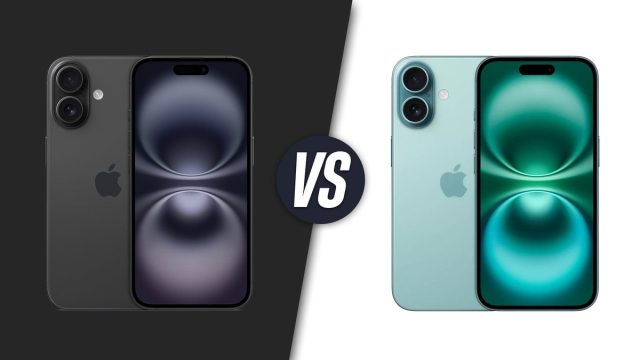Intro
In this comparison, we’ll explore the key differences in design, display, performance, cameras, battery life, and software between the iPhone 17 and iPhone 16 based on everything we know so far.
iPhone 17 vs iPhone 16 expected differences:
| iPhone 17 | iPhone 16 |
|---|---|
| A19 chip (likely 3nm) | A18 chip (3nm) |
| 8 GB RAM | 8 GB RAM |
| 24 MP selfie camera | 12 MP selfie camera |
| 6.27″ OLED display 120Hz ProMotion Thinner bezels |
6.1″ OLED display 60Hz refresh rate Thicker bezels |
| ~3,600 mAh battery | 3,561 mAh battery |
| Similar wired/wireless speeds | 20W wired 25W MagSafe wireless |
| New spliced seamless frame | Sharper edges |
Table of Contents:
Design and Size
We might finally see 120Hz on a non-Pro iPhone
The iPhone 16 stuck closely to Apple’s familiar design formula, with minor changes like the vertical camera layout to support Spatial Video and the addition of the Camera Control button.
The iPhone 17, meanwhile, is expected to introduce a more noticeable design overhaul. A new splicing process will create a smoother transition between the frame and back glass, eliminating the harsher edges of older models for a more seamless feel in the hand.
As for colors, we expect the iPhone 17 to come in similar ones to the iPhone 16, although there’s a good chance we will see new ones. The iPhone 16 colors are Black, White, Pink, Teal, Ultramarine.
Display Differences
The iPhone 16 kept the same 6.1-inch OLED screen size, resolution, and refresh rate as its predecessor. Unfortunately, that meant another year of 60Hz refresh rate, which is increasingly outdated in the $800+ price segment.
However, the iPhone 17 could finally change that story. Leaks suggest it will have a larger 6.27-inch OLED display with ProMotion 120Hz refresh rate, using Samsung’s newer M14 panel. This would offer smoother scrolling, better power efficiency, and potentially even greater peak brightness than the iPhone 16.
Performance and Software
New, supposedly more power-efficient chip
The iPhone 16 debuted with the A18 Bionic chip, built on TSMC’s newer 3nm N3E process. It delivered strong improvements over previous generations, especially in CPU efficiency and sustained performance thanks to a new aluminum thermal system.
Both phones will run iOS 19 when the iPhone 17 launches, but the upcoming Apple Intelligence features aren’t expected until late 2025 or even early 2026.
Camera
New image sensor, but for the selfie camera
Here is a refresher on the iPhone 16 camera setup:
- 48 MP main camera (f/1.6, 24 MP default photos)
- 12 MP ultra-wide (f/2.2, autofocus, Macro support)
- 12 MP selfie camera (f/1.9)
- 48 MP main camera (similar sensor, possibly refined processing)
- 12 MP ultra-wide camera
- 24 MP upgraded selfie camera
The new model still has no telephoto lens, so optical zoom remains reserved for the Pro line.
Battery Life and Charging
Should be pretty similar for both
Specs Comparison
| iPhone 17 | iPhone 16 |
|---|---|
| Size, weight WRITE-HERE |
Size, weight WRITE-HERE |
| Screen 6.7″ OLED 120Hz ProMotion |
Screen 6.1″ OLED 120Hz ProMotion |
| Processor A17 Bionic 3nm |
Processor A17 Bionic 3nm |
| Versions: 8/128GB 8/256GB 8/512GB 8/1TB LPDDR5 |
Versions: 8/128GB 8/256GB 8/512GB 8/1TB LPDDR5 |
| Cameras: 48MP main 12MP ultra 12MP 5X-6X zoom 12MP front |
Cameras: 48MP main 12MP ultra 12MP 3X zoom 12MP front |
| Battery: 4323 mAh* |
Battery: 3200 mAh* |
| Charging: USB-C 27W wired MagSafe |
Charging: USB-C 23W wired MagSafe |
Summary
Performance upgrades will likely be modest, with the A19 chip refining rather than reinventing what the A18 already does well. Battery life and charging will also see incremental improvements rather than major shifts.
If you’re using an iPhone 16 and content with its power, camera quality, and 60Hz display (although that would be hard to believe), the jump to an iPhone 17 might not feel essential. But for anyone coming from an older iPhone — or anyone tired of living without a 120Hz screen — the iPhone 17 could finally deliver the upgrade experience that’s been missing the last two years.
Still, it’s sad that Apple is delaying the hyped up AI features that were supposed to be the main selling point for last year’s model, and it would be even more sad if they are not ready for the iPhone 17 — especially regarding Siri 2.0.











